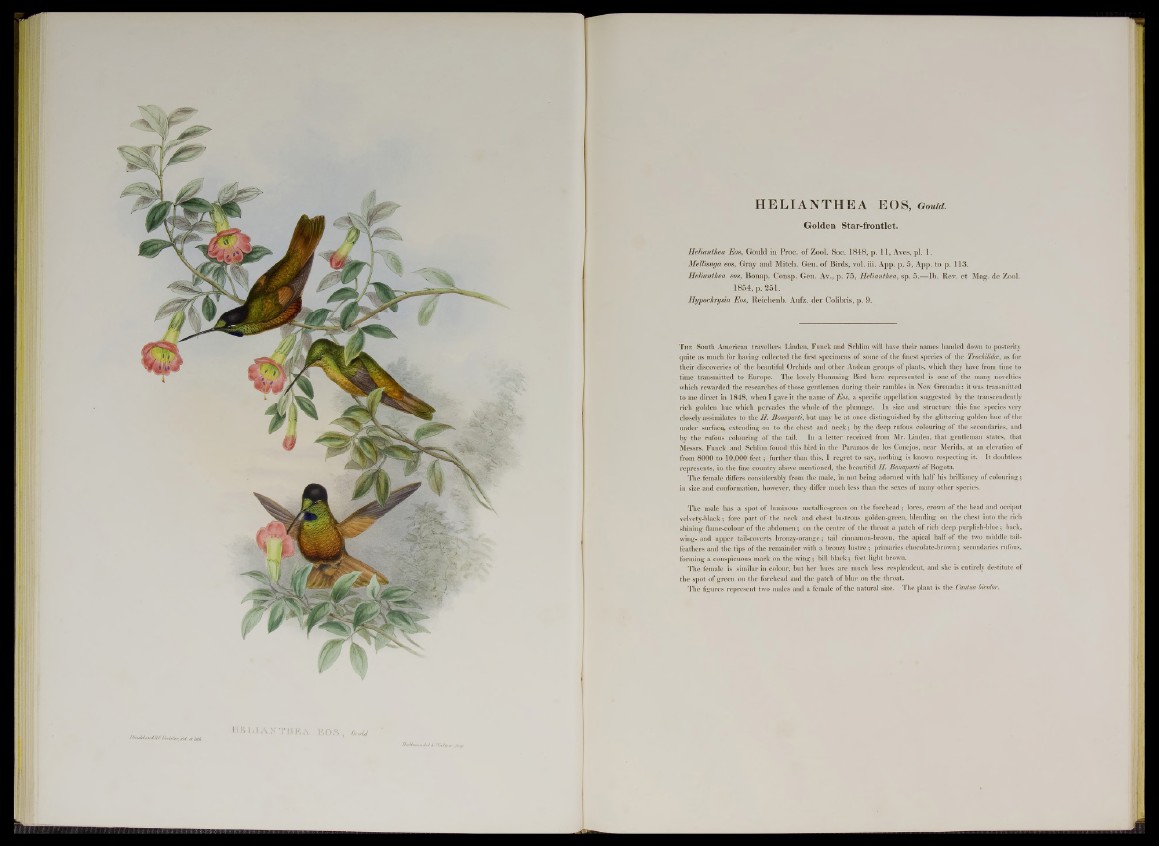
I Q S , GcM
HE L IANTHEA EOS, Gould.
Golden Star-frontlet.
Helianthea Eos, Gould in Proc. o f Zool. Soc. 1848, p. 11, Aves, pi. 1.
Mellisuga eos, Gray and Mitch. Gen. o f Birds, vol. iii. App. p. 5, App. to p. 113.
Helianthea eos, Bonap. Consp. Gen. Av., p. 75, Helianthea, sp. 5.— lb . Rev. e t Mag. de Zool.
1854, p . 251.
Hypochrysia Eos, Reichenb. Aufz. der Cobbris, p. 9.
T he South American travellers Linden, Funck and Schlim will have their names handed down to posterity
quite as much for having collected the first specimens of some of the finest species of the Trochilidce, as for
their discoveries of the beautiful Orchids and other Andean groups of plants, which they have from time to
time transmitted to Europe. The lovely Humming Bird here represented is one of the many novelties
which rewarded the researches of those gentlemen during their rambles in New Grenada: it was transmitted
to me direct in 1848, when I gave it the name of Eos, a specific appellation suggested by the transcendently
rich golden hue which pervades the whole of the plumage. In size and structure this fine species very
closely assimilates to the H. Bonaparti, but may be at once distinguished by the glittering golden hue of the
under surface extending on to the chest and neck; by the deep rufous colouring of the secondaries, and
by the rufous colouring of the tail. In a letter received from Mr. Linden, that gentleman states, that
Messrs. Funck and Schlim found this bird in the Paramos de los Conejos, near Merida, at an elevation of
from 8000 to 10,000 fe e t; further than this, I regret to say, nothing is known respecting it. It doubtless
represents, in the fine country above mentioned, the beautiful H. Bonaparti of Bogota.
The female differs considerably from the male, in not being adorned with half his brilliancy of colouring;
in size and conformation, however, they differ much less than the sexes of many other species.
The male has a spot of luminous metallic-green on the forehead; lores, crown of the head and occiput
velvety-black; fore part of the neck and chest lustrous golden-green, blending on the chest into the rich
shining flame-colour of the abdomen; on the centre of the throat a patch of rich deep purplish-blue; back,
wing- and upper tail-coverts bronzy-orange; tail cinnamon-brown, the apical half of the two middle tail-
feathers and the tips of the remainder with a bronzy lustre ; primaries chocolate-brown; secondaries rufous,
forming a conspicuous mark on the wing; bill black; feet light brown.
The female is similar in colour, but her hues are much less resplendent, and she is entirely destitute of
the spot of green on the forehead and the patch of blue on the throat.
The figures represent two males and a female of the natural size. The plant is the Cantua bicolor.